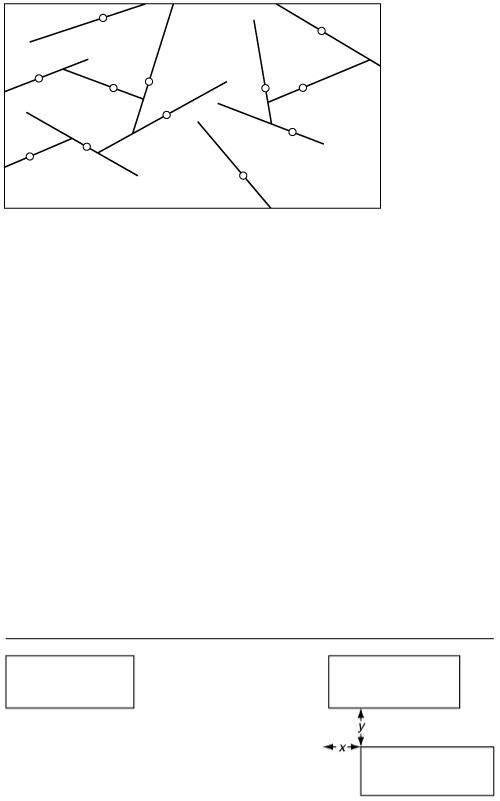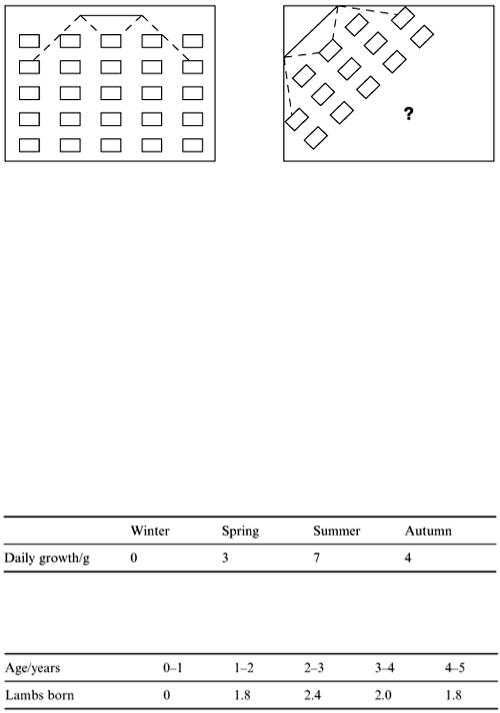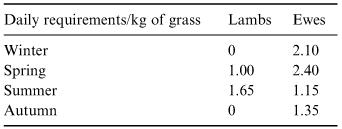
- •Preface
- •1.1 Introduction
- •1.2 Models and modelling
- •1.3 The learning process for mathematical modelling
- •Summary
- •Aims and objectives
- •2.1 Introduction
- •2.2 Examples
- •2.3 Further examples
- •Appendix 1
- •Appendix 2
- •Aims and objectives
- •3.1 Introduction
- •3.2 Definitions and terminology
- •3.3 Methodology and modelling flow chart
- •3.4 The methodology in practice
- •Background to the problem
- •Summary
- •Aims and objectives
- •4.1 Introduction
- •4.2 Listing factors
- •4.3 Making assumptions
- •4.4 Types of behaviour
- •4.5 Translating into mathematics
- •4.6 Choosing mathematical functions
- •Case 1
- •Case 2
- •Case 3
- •4.7 Relative sizes of terms
- •4.8 Units
- •4.9 Dimensions
- •4.10 Dimensional analysis
- •Summary
- •Aims and objectives
- •5.1 Introduction
- •5.2 First-order linear difference equations
- •5.3 Tending to a limit
- •5.4 More than one variable
- •5.5 Matrix models
- •5.6 Non-linear models and chaos
- •5.7 Using spreadsheets
- •Aims and objectives
- •6.1 Introduction
- •6.2 First order, one variable
- •6.3 Second order, one variable
- •6.4 Second order, two variables (uncoupled)
- •6.5 Simultaneous coupled differential equations
- •Summary
- •Aims and objectives
- •7.1 Introduction
- •7.2 Modelling random variables
- •7.3 Generating random numbers
- •7.4 Simulations
- •7.5 Using simulation models
- •7.6 Packages and simulation languages
- •Summary
- •Aims and objectives
- •8.1 Introduction
- •8.2 Data collection
- •8.3 Empirical models
- •8.4 Estimating parameters
- •8.5 Errors and accuracy
- •8.6 Testing models
- •Summary
- •Aims and objectives
- •9.1 Introduction
- •9.2 Driving speeds
- •Context
- •Problem statement
- •Formulate a mathematical model
- •Rewritten problem statement
- •Obtain the mathematical solution
- •9.3 Tax on cigarette smoking
- •Context
- •Problem statement
- •Formulate a mathematical model
- •Obtain the mathematical solution
- •9.4 Shopping trips
- •Context
- •Problem statement
- •Formulate a mathematical model
- •Obtain the mathematical solution
- •Interpret the mathematical solution
- •Using the model
- •9.5 Disk pressing
- •Context
- •Problem statement
- •Formulate a mathematical model
- •Obtain the mathematical solution
- •Interpret the mathematical solution
- •Further thoughts
- •9.6 Gutter
- •Context and problem statement
- •Formulate a mathematical model
- •Obtain the mathematical solution
- •9.7 Turf
- •Context
- •Problem statement
- •Formulate a mathematical model
- •Obtain the mathematical solution
- •Interpret the solution
- •9.8 Parachute jump
- •Context and problem statement
- •Formulate a mathematical model
- •Obtain the mathematical solution
- •9.9 On the buses
- •Context
- •Problem statement
- •Formulate a mathematical model
- •Obtain the mathematical solution
- •9.10 Further battles
- •Discrete deterministic model
- •Discrete stochastic model
- •Comparing the models
- •9.11 Snooker
- •Context
- •Problem statement
- •Formulate a mathematical model
- •Obtain the mathematical solution
- •Interpret the mathematical solution
- •9.12 Further models
- •Mileage
- •Heads or tails
- •Picture hanging
- •Motorway
- •Vehicle-merging delay at a junction
- •Family names
- •Estimating animal populations
- •Simulation of population growth
- •Needle crystals
- •Car parking
- •Overhead projector
- •Sheep farming
- •Aims and objectives
- •10.1 Introduction
- •10.2 Report writing
- •Preliminary
- •Main body
- •Appendices
- •Summary
- •General remarks
- •10.3 A specimen report
- •Contents
- •1 PRELIMINARY SECTIONS
- •1.1 Summary and conclusions
- •1.2 Glossary
- •2 MAIN SECTIONS
- •2.1 Problem statement
- •2.2 Assumptions
- •2.3 Individual testing
- •2.4 Single-stage procedure
- •2.5 Two-stage procedure
- •2.6 Results
- •2.7 Regular section procedures
- •2.8 Conclusions
- •3 APPENDICES
- •3.1 Possible extensions
- •3.2 Mathematical analysis
- •10.4 Presentation
- •Preparation
- •Giving the presentation
- •Bibliography
- •Solutions to Exercises
- •Chapter 2
- •Example 2.2 – Double wiper overlap problem
- •Chapter 4
- •Chapter 5
- •Chapter 6
- •Chapter 8
- •Index
Family names
You are asked to help with a sociological study on the survival and extinction of surnames.
Consider a closed community with N individuals at time t = 0 with K different surnames. Assume that all the children of any marriage take the father's surname.
Make other assumptions as necessary and set up a model with the aim of answering the following questions.
1.What will be the distribution of surnames after x generations?
2.What is the probability that a particular surname becomes extinct?
3.How long will a particular surname survive on average?
Estimating animal populations
One method of estimating the size of a living population occupying a finite region, e.g. fish in a lake, or squirrels in a wood, is to capture a few individuals and mark or tag them.
Suppose that x animals are caught, marked and then released. Some time later, n animals are caught and y of them are found to be marked. What is the best estimate that we can make of the total number N of animals living in the region? How accurate is this estimate likely to be and on what does the accuracy depend?
Derive 95% confidence limits for N. Develop a simulation model to check your answers. What advice would you give on the choice of values for x and n?
Simulation of population growth
Consider the life of an organism as the sequence birth-childhood-adulthood-old age-death. Suppose that an individual is capable of producing offspring only during adulthood and that the production of offspring can be modelled by a Poisson process. Make suitable assumptions about the duration of the three stages childhood, adulthood and old age.
Construct a simulation model which can be used to study the growth of a population starting from three young males and three young females at time t = 0.
Find the size N ( t ) of the population at a later time t and also find t ( n ), the time that it takes for the population to grow to a size n. You should carry out a number of runs of the model and calculate mean values.
Needle crystals
In many chemical and metallurgical processes a surface film of needle-shaped crystals is formed as a substance cools. The crystals appear to start to grow from random points (‘nuclei’) and continue to grow in directly opposed directions. The position of a nucleus and the direction of growth appear to be totally random. The rate of growth stays reasonably constant. The crystals do not push each other apart when they come into contact; in fact, when a growing end touches another segment, that end stops growing and remains attached to the segment that blocked it (Figure 9.33).
We need to know the mean number of crystal ends per unit area which are growing (unblocked) at time t. No method is known for finding this number exactly. You are asked to help as mathematical modellers.

Figure 9.33
1.Select appropriate variables and parameters for defining the problem.
2.Develop a mathematical model with associated software to find the number n(t) of growing ends at time t.
3.Use your model to find how n(t) depends on the other parameters in the problem.
Car parking
A training manual for car drivers wishes to offer the following advice for parking a car neatly into a space in a line of parked cars standing next to a kerb. For backing in, first overshoot the space by x % of a car length and stand off by y % of a car width (Figure 9.34).
1.You are asked to develop a mathematical model which will enable the author of the manual to substitute appropriate values for x and y.
2.What is the minimum gap length L in order for parking to be possible without driving over the kerb?
3.Find similar answers for the problem when driving into the space front wheels first.
4.After parking neatly and doing your shopping, you return to find that another driver has boxed you in. You may still be able to drive out by suitable manoeuvres. Use your mathematical model to investigate what manoeuvres may be necessary.
Figure 9.34
Overhead projector
Figure 9.35 shows a lecture room with 25 desks and an overhead projector and screen. The students at

the sides near the front complain that they cannot see the screen. The lecturer thinks that it might be better to position the projector and screen in one corner of the room and to rearrange the desks.
Figure 9.35
Will this increase the number of students who can see the screen properly? Develop a general model which can be used to answer this question for a rectangular room of any dimensions.
Sheep farming
A prospective sheep farmer has x m 2 of land available for grazing and wishes to have answers to the following questions.
1.How many sheep should he keep?
2.How much of the summer grass should he store as feed for the winter months?
3.What proportion of female lambs should he retain each year for breeding? You are asked to develop a mathematical model to help to answer these questions. Background information
For a particular type of grass (Perennial Ryegrass) on a lowland site the following are approximations to the average growth rate.
In most common breeds of sheep the ewes produce one, two or three lambs each year until they are about 5–8 years old, when they are sold. If we assume that ewes are kept until they are 5 years old, then the following are the average numbers of lambs born per ewe in each age group.
The following are average feeding requirements per animal during the year.

